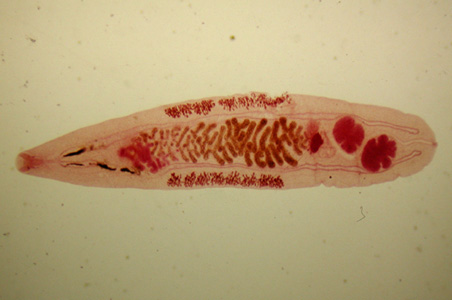Opisthorchiasis is a significant parasitic infection caused by trematodes, primarily Opisthorchis viverrini and Opisthorchis felineus. These liver flukes inhabit the bile ducts of humans and can cause severe hepatobiliary diseases, including cholangitis, cholecystitis, gallstones, and cholangiocarcinoma. Endemic in parts of Southeast Asia and Eastern Europe, opisthorchiasis poses a major public health challenge due to its association with chronic liver damage and cancer.

Etiology: Understanding the Causative Organisms
The primary causative agents of opisthorchiasis are:
- Opisthorchis viverrini – prevalent in Thailand, Laos, Cambodia, and Vietnam
- Opisthorchis felineus – found in Russia, Ukraine, and Kazakhstan
These flukes are transmitted to humans through the ingestion of raw or undercooked freshwater fish harboring infectious metacercariae. Once ingested, the larvae migrate to the bile ducts, where they mature and induce pathological changes.
Life Cycle of Opisthorchis spp.
The life cycle of Opisthorchis involves three hosts: a snail (first intermediate), a freshwater fish (second intermediate), and a definitive host (humans or other fish-eating mammals).
Key Stages:
- Eggs: Released in human feces into freshwater.
- Snails: Eggs ingested by Bithynia snails where miracidia develop into cercariae.
- Fish: Cercariae penetrate fish and form metacercariae.
- Humans: Consumption of infected fish leads to human infection, completing the cycle.
Pathogenesis: How the Parasite Affects the Liver
Once lodged in the intrahepatic bile ducts, the adult flukes induce mechanical irritation, inflammation, and hyperplasia of the biliary epithelium. Chronic infection can result in:
- Periductal fibrosis
- Bile duct obstruction
- Gallstone formation
- Increased risk of cholangiocarcinoma
The World Health Organization has classified Opisthorchis viverrini as a Group 1 carcinogen due to its strong association with bile duct cancer.
Clinical Manifestations of Opisthorchiasis
The symptoms of opisthorchiasis vary based on the intensity and duration of infection.
Acute Phase:
- Fever
- Right upper quadrant pain
- Fatigue and malaise
- Eosinophilia
- Gastrointestinal upset
Chronic Phase:
- Hepatomegaly
- Jaundice
- Intermittent biliary colic
- Weight loss
- Chronic fatigue
- Complications such as cholangitis, pancreatitis, or cholangiocarcinoma
Diagnostic Methods for Opisthorchiasis
Microscopic Stool Examination
Detection of Opisthorchis eggs in feces remains the gold standard for diagnosis. However, low egg output in mild infections may lead to false negatives.
Serological Testing
- ELISA (enzyme-linked immunosorbent assay): Detects antibodies to O. viverrini.
- Rapid diagnostic tests: Useful in endemic regions for field screening.
Imaging Techniques
- Ultrasonography: Identifies bile duct dilatation or fluke-induced inflammation.
- CT/MRI: Helps evaluate complications such as cholangiocarcinoma.
- Endoscopic Retrograde Cholangiopancreatography (ERCP): Provides direct visualization and extraction of adult flukes if needed.
Treatment Options for Opisthorchiasis
Pharmacological Management
Praziquantel is the drug of choice:
- Dose: 25 mg/kg orally, three times a day for one day.
- Mechanism: Increases membrane permeability of the parasite, leading to paralysis and death.
Alternative Treatment:
Albendazole has shown partial efficacy but is not the primary treatment option.
Post-Treatment Monitoring
Follow-up stool examinations are necessary to confirm eradication. In chronic cases with advanced hepatobiliary disease, ongoing clinical monitoring is critical.
Preventive Strategies and Public Health Measures
Preventing opisthorchiasis requires both individual and community-level interventions:
- Avoid raw or undercooked freshwater fish in endemic regions.
- Health education campaigns to inform communities about transmission risks.
- Control of intermediate hosts through environmental and snail control measures.
- Mass drug administration (MDA): Implemented in high-risk populations to reduce disease burden.
- Fish inspection and regulation: Ensuring fish sold in markets is parasite-free.
Opisthorchiasis and Cancer Risk
Chronic opisthorchiasis, particularly due to O. viverrini, significantly elevates the risk of cholangiocarcinoma. Mechanisms involve chronic inflammation, epithelial damage, and nitrosamine exposure from fermented fish consumption. Early detection and screening programs in endemic zones are critical to reducing mortality from this aggressive liver cancer.
Geographic Distribution and Epidemiology
Opisthorchiasis affects over 17 million people globally. The highest burden is concentrated in:
- Thailand and Laos: With prevalence rates in some areas exceeding 50%.
- Vietnam and Cambodia
- Siberia and other parts of Russia (due to O. felineus)
Migratory movements and international trade of infected fish have increased the global relevance of this parasitic disease beyond traditionally endemic zones.
Future Directions in Research and Control
Efforts are ongoing to develop:
- Vaccines against Opisthorchis species.
- Improved diagnostics using molecular techniques.
- Community-based intervention models that combine treatment, education, and fish control.
Opisthorchiasis is a preventable yet neglected tropical disease that poses serious hepatobiliary health risks. Through enhanced awareness, improved diagnostics, and coordinated public health strategies, the burden of this fluke infection can be substantially reduced. Vigilance in endemic regions and among at-risk populations remains paramount for both prevention and early intervention.